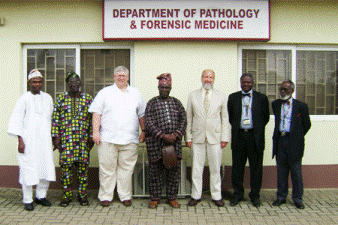Natural Resources, School of

Karl Reinhard Publications
Document Type
Article
Date of this Version
2000
Citation
Chungara, Revista de Antropologia Chilena 2000
Abstract
Repatriation has compromised the opportunity to directly examine skeletons and to apply new diagnostic criteria and techniques. Pre-repatriation approaches to non-metric data acquisition, must make a number of assumptions: ( I ) Phenomena must be correctly identitied and segregated; (2) Criteria for severity must be specific to the phenomena studied; and (3) As criteria for disease rewgnition may change with time, it is valuable only as long as the raw data is also recorded. As part of data preservation, x-rays and CD-ROM images were recorded for skeletons trom Nebraska sites undergoing repatriation. This report concentrates on four of them 250K 13 and slightly more recent 250K2B, 25DKI 0, and 25KXI. 28% of individuals from 250K 13 manifest polyostotic periosteal reaction, and sabre shin reaction was invariably associated with visible surface periosteal reaction. 8-1 4% of individuals from the other sites also had periosteal reaction. Sabre shin reaction, when present in skeletons from those sites, was associated with such complete remodeling that surface periosteal reaction was no longer visible. The patterns of periosteal reaction in the examined sites were in-distinguishable trom those observed on direct examination of skeletons with yaws and syphilis. The Nebraska transition trom yaws to syphilis apparently took place approximately 800 years ago.
La repatriacion ha interferida en fa apartunidad de examillar directamente esquefetas y aplicar nuevas criterias y tecnicas diagnosticas. Las metadas de pre-repatriacion para fa cafeccion de datas na metricas deben Iwcer varias presuncianes: (I) Las {enomenas deben ser carrectamente identificadas y segregadas; (2) Las criterias para severidad deben ser especfjicas en refacion a las fenomenos estudiados; y (3) Como los criterios para ef reconocimiento de enfermedades cambian a traves del tiempa, esta solo es va lido mientras los datos crudas son registrados. Como parte de la preservacion de la data, se tomaron inlligenes de CDROM y rayas x de los esqueletos de los sitios bajo repatriacion de Nebraska. Este trabajo se concentra en cuatro de ellos: 25DK 13 y los ligeramente nUls recientes 25DK2B, 25DK10, y 25KXI. El 28% de los individllos de 25DK13 manfjiestan una reacclon periosteal poliostotica, y "tibias en sable" estaba invariablemente asociado can una visible reaccion periostea en la sllperjicle. El 8-14% de las individuas de atros sitias tambien tenian una reaccion periastal. La reaccion de "tibias en sable ". cuando se hallaba presente en esqueletas de esos silios, estaba asaciada con una reconstruccion tan campleta que la reaccion perioslal de superjicie no era visible. Los patrones de la reacciol1 periostal en las silios examinados no se padian distil1guir de las observadas por examinacion directa en esqueletos con pian y sfjilis. La transicion de pian a sifilis en Nebraska, aparentemente tuva lugar aproximadamente 800 anas atras.
Included in
Archaeological Anthropology Commons, Ecology and Evolutionary Biology Commons, Environmental Public Health Commons, Other Public Health Commons, Parasitology Commons

